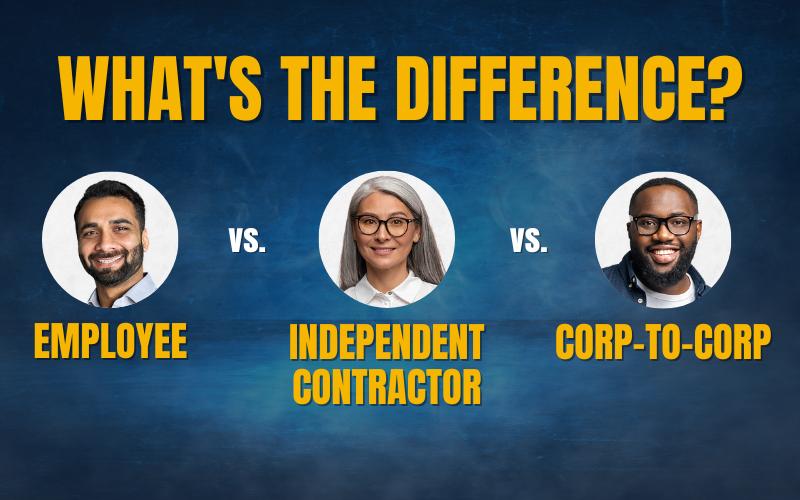If you’ve traditionally employed full-time employees, you might have some questions about the different types of work arrangements that have gained momentum over the past few years. With the rise of the internet and tech companies that have enabled the gig economy, more workers are eschewing full-time employment for the flexibility of less permanent working arrangements — known as the contingent workforce.
This blog post will look at the three different types of contingent workers whom companies can hire and will examine the pros and cons of each. By the end, you’ll be equipped to make more informed decisions about the best way to classify your own company’s workers.
What Is W2 vs. 1099 vs. Corp-to-Corp?
Most employees in the U.S. work for a single company full- or part-time and are what is known as a W2 worker or contracted employee. They get the security of consistent employment (even if it is temporary) and access to the equipment and training necessary to perform the job, but the company gets to dictate almost all of the remaining terms of the arrangement, including when, where, and how the work is accomplished. As a result, these employees are given a W2 tax form at the end of each year. The employer has to pay employer taxes, and withholds the employee taxes and remits to the government on behalf of the worker. Employees also get certain protections that we’ll discuss in the next section.
If you’ve ever wondered what a 1099 position means, it’s simply the classification of a worker as an independent contractor instead of an employee. An independent contractor operates as an unincorporated, individually owned business, and in many ways, these workers can be viewed as the opposite of a W2 employee. They are responsible for paying their own taxes, both at filing time and quarterly throughout the year, and holding a 1099 position means they aren’t entitled to receive any of the traditional benefits that accompany full-time employment, such as retirement plans and health insurance. There are many different types of independent contractors, but a few examples include Uber drivers, freelance writers, graphic designers, photographers, consultants, and many other self-employed business owners and skilled workers that specialize in a trade.
Companies can also hire corp-to-corp workers by engaging the services of an incorporated contractor. The arrangement of corp-to-corp versus 1099 is similar, but it means you’ll pay an LLC or corporation, rather than the worker, for the worker’s services. In addition, the contracted corp-to-corp worker must own an LLC or a corporation. If Nike hires a shoe design consultant who owns Savvy Sneakers, LLC, for example, Nike is engaging the worker under a corp-to-corp arrangement.
Responsibilities When Hiring Contingent Workers
When a company engages a W2 employee, the company has a host of responsibilities they must attend to beyond writing a paycheck each month. Those responsibilities include providing a safe work environment, offering the necessary training, paying employer taxes, withholding employee taxes to remit to the government, and issuing W2 tax forms at the end of each year. In addition, the Fair Labor Standards Act (FLSA) ensures that W2 employees receive at least minimum wage and overtime pay (for non-exempt employees) while also enforcing certain record-keeping requirements.
Companies with 50 or more employees must provide health benefits according to the Affordable Care Act, and certain local and state jurisdictions also require employers to offer paid sick leave and other paid leaves such as disability and parental. Other benefits aren’t mandatory but remain common for companies to offer, including paid time off, 401(k) retirement plans, long-term disability, and flexible spending accounts (FSAs).
When a company engages a 1099 or corp-to-corp worker, on the other hand, that list of responsibilities shrinks dramatically. Besides paying the agreed-upon rate as stated in a standard 1099 contract or corp-to-corp contract agreement, the hiring company must issue the appropriate tax documents such as Form 1099-NEC (for 1099 independent contractor compensation).
The Benefits of Each Worker Classification
Although it’s obvious that companies have more obligations toward W2 versus 1099 and corp-to-corp workers, there are pros and cons for each type of engagement. For example, W2 employees are typically working for only your company, and they contribute an enormous amount to establishing the kind of culture you want to have. Your company also has granular control over when, where, and how W2 employees perform the work they’ve been hired to do, which isn’t necessarily the case with independent contractors.
That said, hiring a 1099 worker allows you to bring specialized skills into your organization without having to navigate a time-consuming hiring process or woo potential employees with expensive benefits packages. Outsourcing certain projects or skills gives you the flexibility to accomplish tasks that might be beyond your existing employee base and outside the normal function of your business. A corp-to-corp worker comes with the same benefits, but they also protect your company from some of the dangers of misclassification because a vetted corporation is performing the work instead of an individual.
Tax Rate for 1099 vs. W2 vs. Corp-to-Corp
Taxes are an important — and expensive — consideration when hiring temporary W2 employees. Your company must pay all employer taxes, including the 6.2% federal income tax as dictated by the Federal Insurance Contributions Act (FICA), another 1.45% for Medicare, a state unemployment tax ranging from 0.5% to 14% (depending on the state the worker is in), and a federal unemployment tax of 0.6%. These taxes add up, particularly when viewed next to the nonexistent tax burden associated with 1099 independent contractors, who must pay their own self-employment taxes and income tax. However, they can take tax deductions to significantly lower their tax liability. Corp-to-corp workers are also responsible for their own business taxes as an LLC or incorporated entity.
Contingent Worker Contracts
Different types of contingent workers rely on different contingent worker contracts. The standard 1099 contract speaks directly to the relationship between the two parties, and the “recitals” section on page one identifies each party and their contractual partnership. A 1099 worker contract should include clear expectations and deliverables for the independent contractor, but it doesn’t include when and how the work is to be completed because independent contractors have full control over their work and time.
In corp-to-corp contract agreements, the difference is mostly in the recitals section, which lists two companies in partnership instead of a company and an individual contractor. Like the 1099 worker contract, the corp-to-corp contract doesn’t specify how the outside corp will accomplish the receivables dictated in the contract.
As you are probably familiar with, an engagement with a W2 employee begins upon acceptance of a formal job offer outlining the employee’s position and responsibilities. This acceptance also initiates the employer/employee relationship and creates the obligations on behalf of the employer.
Determining the Right Work Arrangement for Your Next Hire
Now that you know the basic requirements for the different types of contingent workers, you can determine whether W2 versus 1099 or corp-to-corp is right for your company.
However, despite the benefits of hiring contingent workers, your company may have certain policies that encourage or prohibit the use of them, particularly regarding 1099 workers, so it’s a good idea to talk to someone in your human resources department prior to posting any job openings.
If you receive the green light to engage a 1099 independent contractor, it’s important to implement a thorough vetting process or outsource this classification step to a third-party. This should cover how the company plans to engage the worker, but also whether the company wants control over how, when, and where the worker provides services, whether existing employees perform the same or similar work, and whether the services provided are core to the business or something outside the company’s normal scope. In addition, the vetting process should determine whether the 1099 or corp-to-corp is a truly independent business that promotes itself to the marketplace and takes on other clients.
These steps might seem overly cautious, but they help ensure that the worker classification is in line, and therefore help your company avoid potentially significant liabilities resulting from misclassification. Worker classification issues are increasingly common, and the matter recently took center stage when ride-sharing companies such as Uber and Lyft were told by the California Supreme Court that their drivers should be classified as employees instead of independent contractors.
However, that ruling was ultimately overturned by a proposed exemption for gig economy workers known as Proposition 22 — a measure that 58% of Californians voted to approve in November 2020. Had the measure failed, the ride-sharing and delivery startups would have lost the $200 million they spent supporting the measure with the “Yes on Prop. 22” campaign. But they might also have been forced to pay millions more in overtime and federal income tax on behalf of their newly classified employees. It’s an important lesson about the perils of worker classification issues and a strong reason why you should familiarize yourself with the different types of contingent workers.
Is your company clear on your worker classifications? Learn more about employee misclassification and risk mitigation, and take a quick assessment with our Risk Calculator. This interactive tool assesses your risk level, liability, and penalties and fees in just a few steps.
Written by: Sara Jensen, Vice President of Business Development at IES
Sara Jensen is the vice president of business development at Innovative Employee Solutions (IES), aleading global Employer of Record in more than 150 countries that specializes in contingent workforce solutions such as outsourced payrolling, independent contractor compliance, and contractor management services. Founded in 1974, IES has grown into one of San Diego’s largest women-owned businesses and has been named one of the city’s “Best Places to Work” for 10 years in a row.








